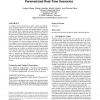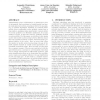65 search results - page 13 / 13 » A behavioral theory of insider-threat risks: A system dynami... |
TNN
2010
13 years 1 months ago
2010
In this paper we provide theoretical and numerical analysis of a geometric activity flow network model which is aimed at explaining mathematically the scale-free functional graph s...
SCESM
2006
ACM
14 years 12 days ago
2006
ACM
As technical systems keep growing more complex and sophisticated, designing software for the safety-critical coordination between their components becomes increasingly difficult....
ATAL
2008
Springer
13 years 8 months ago
2008
Springer
We address the learning of trust based on past observations and context information. We argue that from the truster's point of view trust is best expressed as one of several ...
SIGMETRICS
2009
ACM
14 years 29 days ago
2009
ACM
Disseminating a piece of information, or updates for a piece of information, has been shown to benefit greatly from simple randomized procedures, sometimes referred to as gossipi...
JSAC
2007
13 years 6 months ago
2007
— One of the distinctive features in a wireless ad hoc network is lack of any central controller or single point of authority, in which each node/link then makes its own decision...


